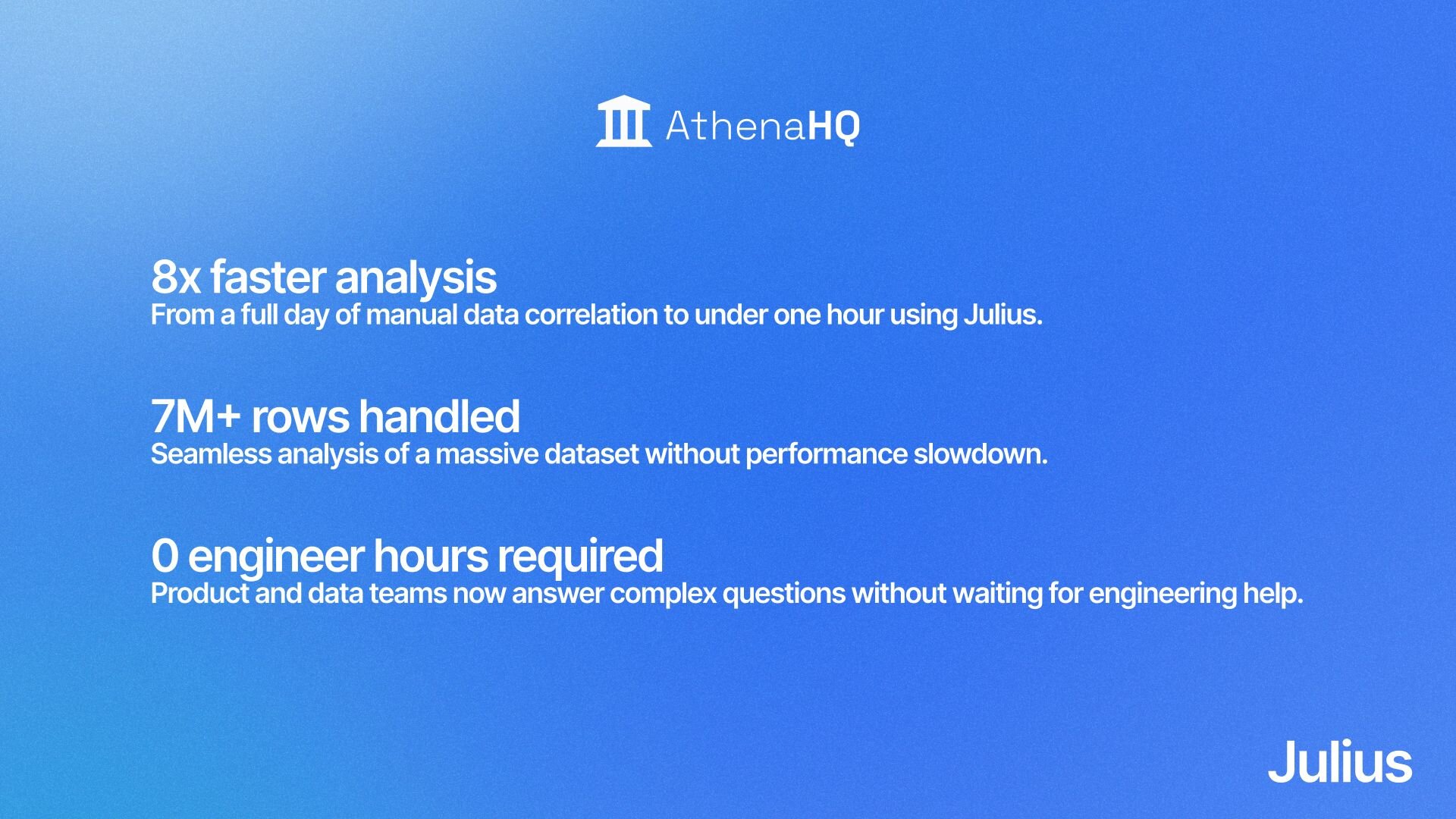October 23rd, 2025
How AthenaHQ turned a full day of data work into under an hour with Julius
By Simon Avila · 4 min read
“We treat product work like a scientific process. Julius lets us test hypotheses fast without pulling an engineer into the room.”
– Andrew, Founder and CEO
About AthenaHQ
AthenaHQ is building the future of AI-powered search visibility. Their platform helps teams and enterprises harness large-scale data to succeed with AI search. For Andrew, AthenaHQ’s founder and CEO, that means treating product development like a scientific process, forming hypotheses from customer insights and validating them rapidly with data.
When a scientific culture hits a data bottleneck
AthenaHQ’s product questions were clear. Which activation points inside the product predict conversion? Where do users continue to find value over time? Which experiences drive expansion?
The friction was in the path from question to answer.
Before Julius, answering even basic questions meant pulling an engineer into the room. Engineers had to figure out which tables to query, write SQL, merge results across multiple sources, and repeat that cycle whenever the team learned something new. As Andrew puts it, that work “can get very gnarly very fast.”
For Renan, AthenaHQ's evangelist, the pain came from a different angle. "We're querying a database with 7 million rows—it was crazy, things were really slow," he explains. The team tried other solutions: Supabase for querying and plotting helped a little, but Renan still had to manually correlate data points, making the insights "not really useful."
He even tried using ChatGPT to help with queries and data analysis, but hit a fundamental limitation: "ChatGPT doesn't have the context of the database. It can't ingest 7 million data rows."
The solution: Julius as the data scientist in the room
The impact on Renan's workflow was dramatic and measurable. "I remember the first data correlation I was doing on other platforms took me a full day to plot some simple charts and correlate the data by myself," he recalls. "But with Julius, it took me one hour or less to build the same charts, correlate the data, and have it guide me with an answer based on the data."
That's not just a time saver—it's an 8x improvement in speed, transforming what was once a full-day project into something that can be completed in a single hour.
For Andrew and the leadership team, Julius enabled something even more valuable: the ability to rapidly test hypotheses and validate assumptions. Instead of waiting for engineering resources to free up, the team could iterate on questions and dive deeper into their data in real-time.
The scientific process that drives AthenaHQ's product development now moves at the speed of thought rather than the speed of SQL queries. Customer conversations can turn into tested hypotheses within hours instead of days or weeks.
The strategic advantage: speed in a fast-moving market
In the rapidly evolving AI search space, speed of learning translates directly to competitive advantage. AthenaHQ's ability to quickly test hypotheses about customer activation, conversion patterns, and value delivery means they can iterate faster than competitors stuck in slower analytical processes.
The 7 million rows of citations data—tracking which websites different AI models pull from across various verticals and geographies—represents a goldmine of market intelligence. But that intelligence only matters if it can be extracted quickly enough to inform decisions.
"Being able to analyze the data and test hypotheses in a really rapid fashion is really valuable," Andrew explains. In the AI search market where customer expectations and competitive dynamics shift rapidly, this rapid hypothesis testing can mean the difference between leading the market and playing catch-up.

What changed for the team
Hypotheses tested in hours, not sprints
Product managers can validate activation hypotheses quickly without waiting for engineering bandwidth.
Self-serve correlation at scale
Renan’s first multi-source correlation took a full day in other platforms. With Julius the same work took an hour or less and produced a guided, defensible answer.
Fewer handoffs, tighter feedback loops
Teams move from idea to insight to iteration in a single working session.
Deeper analysis, not just faster charts
Julius’ recommendation surfaced patterns that simple aggregations would miss.
Sample use cases at AthenaHQ
Activation analysis
Identify the precise in-product actions and thresholds that correlate with conversion and long term value.
Citations quality monitoring
Drill into which sources models rely on by vertical and geography, then track shifts over time to maintain quality.
Product-market fit instrumentation
Rapidly test which combinations of features and experiences predict retention.
Results that matter
- • From a day to under an hour for complex, multi-table correlations.
- • Near zero engineer time required for most exploratory analysis.
- • Higher confidence in decisions thanks to transparent queries and explanations that anyone on the team can review.
Renan sums it up simply: other tools helped him run queries, but Julius helped him connect the dots and get to an answer the team could act on.
Why it works
AthenaHQ already had the right questions and a scientific mindset. Julius removed the friction between questions and data by combining three capabilities in one place:
1. Natural language to generate accurate SQL and explain the logic.
2. Scale to handle millions of rows without manual stitching.
3. Built in advanced analytics to uncover relationships traditional BI tools miss.
